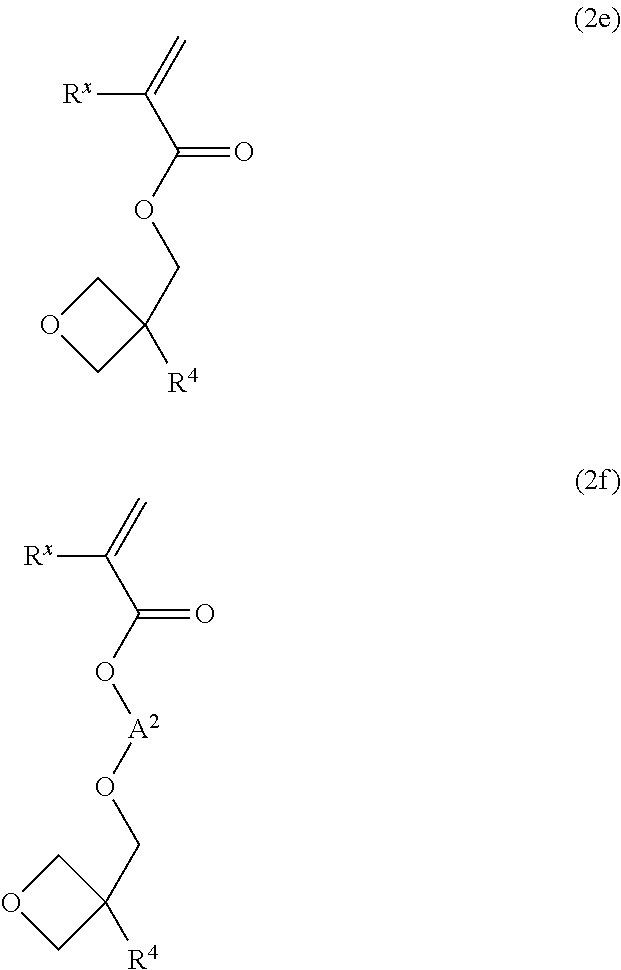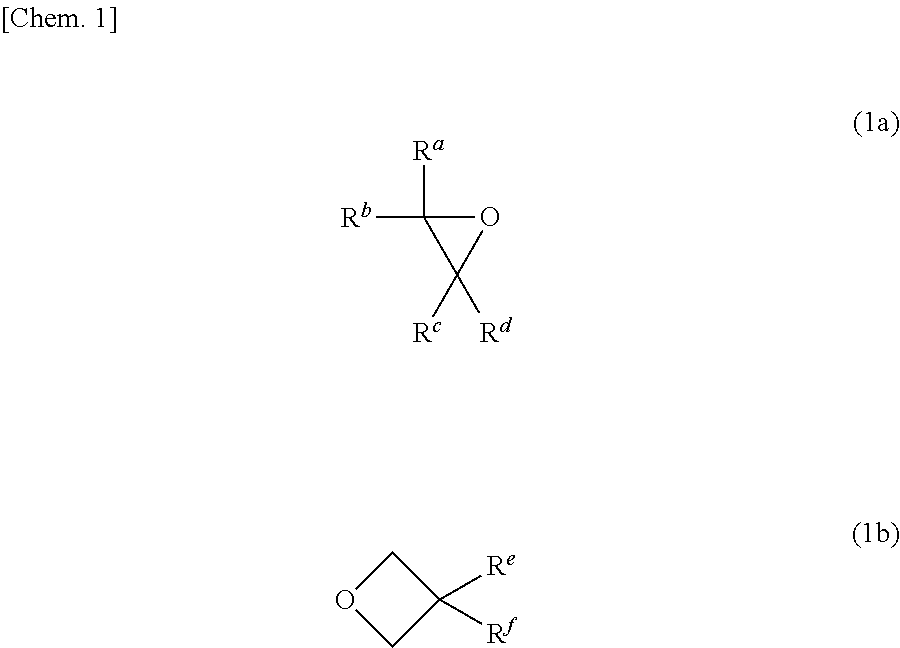Radical-polymerizable resin, radical-polymerizable resin composition, and cured material thereof
a technology polymerizable resin, which is applied in the field of radical polymerizable resin, can solve the problems of peeling (separation) at the adhesive interface, thin-walled, fragile, and thereby liable to break, and achieve excellent adhesiveness and satisfactory flexibility
- Summary
- Abstract
- Description
- Claims
- Application Information
AI Technical Summary
Benefits of technology
Problems solved by technology
Method used
Image
Examples
example 1
Production of Radical-polymerizable Resin
[0074]A mixture (monomer mixture) of 9.28 g of toluene, 4.41 g (34.4 mmol) of glycidyl acrylate (GA), 17.2 g (172 mmol) of 1,2-epoxyhexane, and 0.0385 g of p-methoxyphenol was placed in a three-necked flask equipped with an initiator-dropping line, a N2 line, and a thermometer, followed by temperature adjustment to 25° C. Next, a mixture of 5.60 g of toluene and 0.95 g (6.60 mmol) of boron trifluoride diethyl etherate (BF3OEt2) was quantitatively added dropwise over 2 hours using a delivery pump. The resulting mixture after the completion of dropwise addition was held for 4 hours to yield a resin composition. This was purified by precipitation from five times the amount of methanol (containing 0.1% of p-methoxyphenol), held in a vacuum dryer (40° C., full vacuum) for 20 hours, and yielded a colorless, transparent liquid resin (C1).
[0075]The resin (C1) had a number-average molecular weight (Mn) of 600 and a weight-average molecular weight (Mw)...
example 2
Production of Radical-polymerizable Resin
[0076]A mixture (monomer mixture) of 10.3 g of toluene, 6.76 g (34.4 mmol) of 3,4-epoxycyclohexylmethyl methacrylate (trade name “CYCLOMER M-100,” supplied by Daicel Chemical Industries, Ltd. (now Daicel Corporation)), 17.2 g (172 mmol) of 1,2-epoxyhexane, and 0.0385 g of p-methoxyphenol was placed in a three-necked flask equipped with an initiator-dropping line, a N2 line, and a thermometer, followed by temperature adjustment to 25° C. Next, a mixture of 5.60 g of toluene and 0.95 g (6.60 mmol) of BE3OEt2 was quantitatively added dropwise over 2 hours using a delivery pump. The resulting mixture after the completion of dropwise addition was held for 4 hours to yield a resin composition. This was purified by precipitation from five times the amount of methanol (containing 0.1% of p-methoxyphenol), held in a vacuum dryer (40° C., full vacuum) for 20 hours, and yielded a colorless, transparent liquid resin (C2).
[0077]The resin (C2) had an Mn of...
example 3
Production of Radical-polymerizable Resin
[0078]A mixture (monomer mixture) of 9.90 g of toluene, 5.86 g (34.4 mmol) of 3-ethyl-3-oxetanylmethyl acrylate (trade name “OXE-10,” supplied by Osaka Organic Chemical Industry Ltd.), 17.2 g (172 mmol) of 1,2-epoxyhexane, 0.0385 g of p-methoxyphenol was placed in a three-necked flask equipped with an initiator-dropping line, a N2 line, and a thermometer, followed by temperature adjustment to 25° C. Next, a mixture of 5.60 g of toluene and 0.95 g (6.60 mmol) of BF3OEt2 was quantitatively added dropwise over 2 hours using a delivery pump. The resulting mixture after the completion of dropwise addition was held for 4 hours to yield a resin composition. This was purified by precipitation from five times the amount of methanol (containing 0.1% of p-methoxyphenol), held in a vacuum dryer (40° C., full vacuum) for 20 hours, and yielded a colorless, transparent liquid resin (C3).
[0079]The resin (C3) had an Mn of 5000 and an Mw of 8500 as molecular w...
PUM
| Property | Measurement | Unit |
|---|---|---|
| temperature | aaaaa | aaaaa |
| temperature | aaaaa | aaaaa |
| temperature | aaaaa | aaaaa |
Abstract
Description
Claims
Application Information
 Login to View More
Login to View More - R&D
- Intellectual Property
- Life Sciences
- Materials
- Tech Scout
- Unparalleled Data Quality
- Higher Quality Content
- 60% Fewer Hallucinations
Browse by: Latest US Patents, China's latest patents, Technical Efficacy Thesaurus, Application Domain, Technology Topic, Popular Technical Reports.
© 2025 PatSnap. All rights reserved.Legal|Privacy policy|Modern Slavery Act Transparency Statement|Sitemap|About US| Contact US: help@patsnap.com



